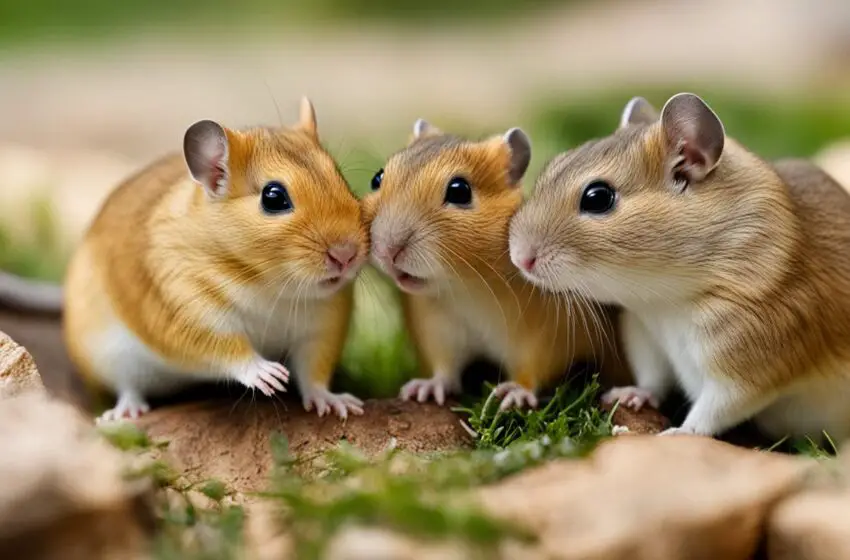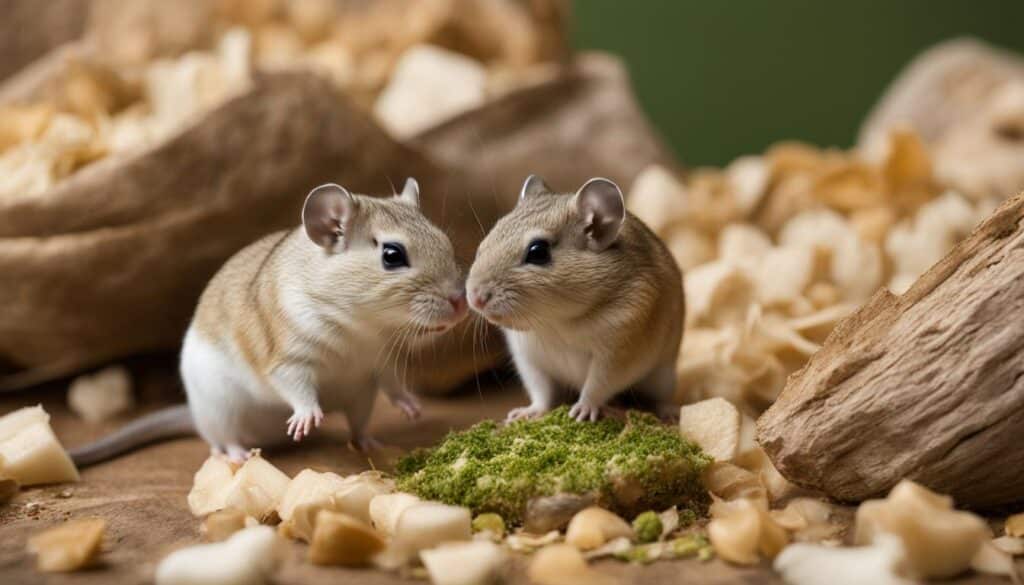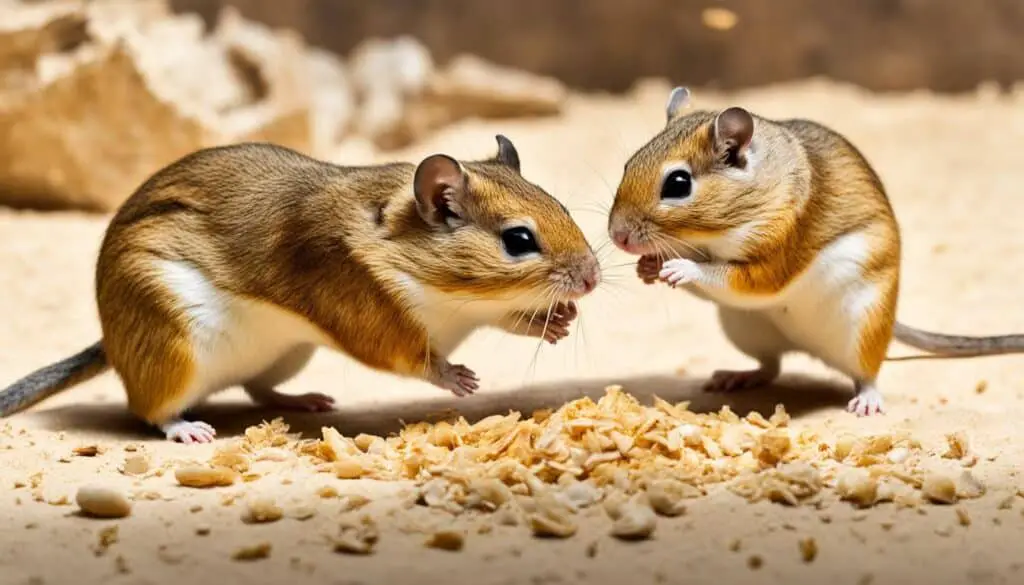Managing Social Dynamics Among Gerbils

Gerbils are fascinating creatures that thrive in a social community, where they engage in various interactions and establish unique social dynamics. As a gerbil owner, understanding and managing their behavior is crucial for fostering a harmonious gerbil community and ensuring the well-being of these small, furry companions.
When it comes to managing gerbil social dynamics, it’s important to recognize that these rodents have intricate hierarchies and communication systems. By gaining insight into their behavior and implementing appropriate strategies, we can create a nurturing environment that promotes positive interactions.
In this article, I will explore various aspects of gerbil social dynamics, including understanding their behavior, introducing new gerbils to the community, providing enrichment and stimulation, managing aggression and conflicts, and creating a suitable environment. By following these guidelines, you can establish a healthy gerbil community where these charming creatures can flourish.
Key Takeaways:
- Gerbils are social animals that thrive in a community setting.
- Understanding gerbil behavior is essential for managing their social dynamics effectively.
- When introducing new gerbils, follow a gradual and controlled process.
- Providing enrichment and stimulation is crucial for preventing boredom and territorial behavior.
- Manage aggression and conflicts by identifying underlying causes and promoting positive interactions.
Understanding Gerbil Social Behavior
Gerbils are fascinating creatures with a complex social structure that revolves around hierarchy and communication. Within a gerbil community, there is usually a dominant gerbil that assumes leadership and determines the social order. This hierarchy is established through a series of interactions and displays of dominance.
Gerbils communicate with each other using various vocalizations, body language, and scent marking. Vocalizations can include chirping, squeaking, and drumming sounds, which serve as a means of conveying different messages to other gerbils. Body language, such as tail wagging, grooming, and the raising of the ears, also plays a crucial role in communication.
Understanding and interpreting these communication methods is essential for managing gerbil social dynamics effectively.
Gerbils also engage in scent marking, which involves rubbing their bodies on objects within their environment to establish territories and communicate their presence. By leaving their scent behind, gerbils can convey information to other gerbils, such as their reproductive status or availability for mating.
By observing and interpreting these behaviors, gerbil owners can gain insight into the social dynamics within their gerbil community and take appropriate actions to ensure a harmonious environment. Understanding the social hierarchy and how gerbils communicate can help prevent conflicts and promote peaceful interactions among gerbils.
Gerbil Hierarchy and Dominance
In a gerbil community, there is typically a dominant gerbil that assumes a leadership role. This dominant gerbil exhibits behaviors such as chasing, mounting, and vocalizing to assert its dominance over other gerbils. The dominant gerbil enjoys certain privileges, such as access to resources like food and shelter.
Other gerbils in the community will exhibit submissive behaviors, such as lowering their bodies, avoiding eye contact, or grooming the dominant gerbil. These behaviors help maintain social order and reduce conflicts within the community. It is important to note that gerbil hierarchy may change over time, especially with the introduction of new gerbils or the loss of the dominant gerbil.
Gerbil Communication and Interaction
Gerbils communicate through a combination of vocalizations, body language, and scent marking. Their vocalizations serve as a way to express emotions, indicate danger, or announce their presence. Body language cues, such as raised fur, stomping, or tail wagging, can convey messages of aggression, fear, or submission.
Scent marking is another crucial aspect of gerbil communication. Gerbils have scent glands on various parts of their bodies, and they use these glands to mark their territory and communicate with other gerbils. By understanding the significance of scent marking, gerbil owners can create an enriched environment that allows gerbils to express their natural behaviors and instincts.
Introducing New Gerbils to the Community
When introducing new gerbils to an existing community, it’s crucial to follow a gradual and controlled process to ensure a successful integration. The key to a smooth introduction is to provide a neutral territory where the gerbils can become acquainted with each other’s scent without feeling threatened or territorial.

To begin the process, set up a separate neutral space, such as a clean, empty enclosure or a playpen, where the gerbils can interact for short periods under supervision. This helps prevent any potential territorial behavior and allows them to begin establishing a bond. It’s essential to closely monitor their interactions during this initial stage to identify any signs of aggression or dominance.
Scent swapping is an effective technique to familiarize the gerbils with each other’s scent before they physically meet. This can be done by exchanging bedding between their living spaces or rubbing a cloth on each gerbil and placing it in the other gerbil’s territory. This gradual exposure helps the gerbils become accustomed to each other’s scent and reduces the likelihood of aggression during the introduction process.
When it’s time for the gerbils to physically meet, ensure there are separate living spaces available within the main enclosure. This provides a safe retreat for each gerbil and reduces the risk of fights breaking out. These separate living spaces can be created using cardboard dividers or wire mesh, allowing visual and olfactory contact while maintaining physical separation.
Continue to closely observe the gerbils’ behavior during this bonding process, looking out for signs of aggression, fear, or distress. If any conflicts arise, it may be necessary to separate the gerbils temporarily and repeat the scent swapping and neutral territory interactions until they become more comfortable with each other’s presence.
Introducing New Gerbils: Step-by-step Guide
- Set up a clean, neutral territory for the gerbils to meet.
- Allow short supervised interactions in the neutral territory, closely monitoring their behavior.
- Practice scent swapping to familiarize the gerbils with each other’s scent.
- Provide separate living spaces within the main enclosure to prevent aggression.
- Continue observing their behavior and adjust the introduction process as needed.
By following these steps and allowing the gerbils time to adjust, bond, and establish their hierarchy, you can increase the chances of a successful integration and a harmonious gerbil community.
Providing Enrichment and Stimulation
Keeping gerbils entertained and mentally stimulated is crucial for preventing boredom and territorial behavior. By providing a variety of toys, tunnels, and hiding spots in their enclosure, you can stimulate their natural instincts and promote a healthy and enriched environment.
Gerbils are curious creatures that love to explore and engage their senses. Incorporating interactive toys such as balls, chew toys, and puzzle feeders can keep them mentally engaged and physically active. These toys not only provide entertainment but also help in satisfying their natural instincts to gnaw and burrow.
One popular option is a gerbil wheel, which allows them to run and expend their energy. Make sure to choose a wheel that is the right size and doesn’t have any gaps to avoid any potential harm to their feet or tails.
“Enrichment toys are essential for gerbils as they provide mental stimulation and prevent boredom. It is important to rotate the toys regularly to maintain their interest and prevent them from getting bored.”
Hiding spots and tunnels are also great additions to the gerbil enclosure. You can use tunnels made of cardboard or PVC pipes, as well as small wooden houses or coconut hides. These provide secure areas for gerbils to relax, sleep, and escape when needed.
Regular handling and interaction with gerbils are equally important for their well-being. It helps in building trust between you and your furry friends, and also promotes socialization. Gradually introducing your scent to them through gentle strokes and offering treats can make them more comfortable with human contact.
Frequently Asked Questions
- Q: How many toys should I provide for my gerbils?
- Q: Can I use household items as gerbil toys?
- Q: How often should I interact with my gerbils?
A: It is recommended to have at least 3-4 different types of toys to keep them engaged and prevent boredom.
A: Yes, but ensure that the items are safe for gerbils to chew and play with. Avoid anything made of toxic materials or with small parts that could be swallowed.
A: Aim for daily interaction, even for short periods of time. Gerbils are social animals and enjoy human interaction, but remember to respect their need for rest and downtime.
Managing Aggression and Conflict
Gerbils are generally social animals that live harmoniously in a community setting. However, it is not uncommon for gerbils to exhibit aggression and conflicts within their group. Understanding the underlying causes of such behaviors and implementing appropriate strategies is crucial in managing gerbil aggression and resolving conflicts effectively.
Resource guarding and territorial behavior are common triggers for gerbil aggression. It is important to identify these root causes and address them appropriately to prevent further conflicts. Providing ample resources such as food, water, and hiding spots can help minimize competition and reduce aggression.
In addition to resource management, temporarily separating gerbils involved in conflicts can be beneficial. This allows them to cool down and reduces the chances of escalated fighting. After a period of separation, supervised reintroductions can be conducted, promoting positive interactions and gradual reintegration into the community.
Creating a stimulating and enriched environment for gerbils can also help manage aggression. Gerbil toys, tunnels, and climbing structures provide outlets for their energy and natural instincts. Regular environmental enrichment and mental stimulation can prevent boredom and redirect their focus away from conflicts.
It is important to note that some conflicts may escalate to a level where intervention from a veterinarian or animal behaviorist is necessary. In severe cases, gerbils may need to be permanently separated to ensure their safety and well-being.
Common Causes and Solutions for Gerbil Aggression
| Causes | Solutions |
|---|---|
| Resource guarding | – Provide ample resources to minimize competition – Separate aggressive gerbil during feeding times – Implement a feeding schedule |
| Territorial behavior | – Ensure enough space for each gerbil to establish territories – Introduce new gerbils gradually and in neutral territory – Monitor and intervene if territorial disputes arise |
| Social hierarchy conflicts | – Allow gerbils to establish a natural pecking order – Provide enough space and resources for gerbils at different hierarchy levels – Supervise interactions and provide distractions to redirect aggression |
| Lack of socialization | – Handle and interact with gerbils regularly to promote social bonding – Provide opportunities for gerbils to interact with humans and other friendly animals |
Resolving conflicts among gerbils requires patience, observation, and appropriate intervention. By understanding the causes of gerbil aggression and implementing effective strategies, you can create a peaceful and harmonious community for your gerbils to thrive in.

Creating a Suitable Environment
A properly designed gerbil habitat is vital for managing their social dynamics. The enclosure should offer ample space for gerbils to establish territories and engage in their natural behaviors. Creating a habitat that mimics their natural environment can promote a sense of security and well-being among gerbils.
When designing a gerbil enclosure, consider incorporating tunnels, platforms, and hideouts to provide a variety of enrichment opportunities. These elements allow gerbils to engage in climbing, exploring, and exercising, promoting both physical and mental stimulation.
The choice of bedding material is also crucial for gerbils’ comfort and cleanliness. Opt for safe and absorbent bedding options such as paper-based or aspen shavings, avoiding cedar or pine bedding, which can be harmful to their respiratory system.
Proper ventilation is essential to maintain a fresh and odor-free environment. Ensure that the enclosure has adequate airflow to prevent the buildup of ammonia and other harmful gases that can negatively impact gerbils’ health.
Temperature and lighting conditions should be kept within the optimal range for gerbils. Providing a temperature-controlled habitat between 65°F and 75°F (18°C to 24°C) and exposure to natural light or UVB lighting can contribute to their overall well-being.
Creating a suitable environment not only enhances gerbils’ physical health but also promotes harmonious social interactions within their community. A well-designed habitat allows gerbils to express their natural behaviors and instincts, reducing the likelihood of conflicts and stress among them.
Conclusion
Successfully managing gerbil social dynamics is vital for creating a harmonious and thriving gerbil community. By understanding their behavior and implementing appropriate strategies, we can ensure the well-being and happiness of these social animals.
Creating a suitable environment for gerbils is the first step in managing their social dynamics. Providing enough space for them to establish territories and engage in natural behaviors is essential. Additionally, choosing the right bedding material and maintaining proper ventilation, temperature, and lighting contribute to their overall well-being.
When introducing new gerbils to the community, a gradual process with scent swapping and careful monitoring is crucial. This helps in familiarizing gerbils with each other’s scent and minimizing potential aggression. Enrichment and stimulation through toys, tunnels, and regular human interaction also play a significant role in preventing boredom and fostering socialization.
Aggression and conflicts among gerbils may occur, but by identifying the root causes and addressing them appropriately, we can effectively manage these situations. Separating gerbils temporarily, providing enough resources and space, and encouraging positive interactions can help reduce aggression and resolve conflicts.
With proper management techniques in place, gerbils can lead happy and socially balanced lives in their community. By understanding their social behavior, creating a conducive environment, and addressing conflicts promptly, we can ensure the harmony and well-being of our gerbil companions.
FAQ
What is the social behavior of gerbils?
Gerbils have a complex social structure that revolves around hierarchy and communication. They communicate through vocalizations, body language, and scent marking.
How do I introduce new gerbils to an existing community?
It is important to follow a gradual and controlled process. Start with neutral territory and use scent swapping techniques. Monitor their interactions closely and provide separate living spaces initially.
How can I keep gerbils entertained and mentally stimulated?
Providing a variety of toys, tunnels, and hiding spots in their enclosure can stimulate their natural instincts. Regular handling and interaction with humans can also help in developing a bond with the gerbils and promoting socialization.
What should I do if gerbils exhibit aggression and conflicts in the community?
Identify the underlying causes, such as resource guarding or territorial behavior, and address them appropriately. Separate gerbils temporarily, provide enough resources and space, and promote positive interactions.
How should I create a suitable environment for gerbils?
The enclosure should provide enough space for gerbils to establish territories and engage in natural behaviors. Choose appropriate bedding material for gerbils’ comfort and cleanliness. Consider proper ventilation, temperature, and lighting.



